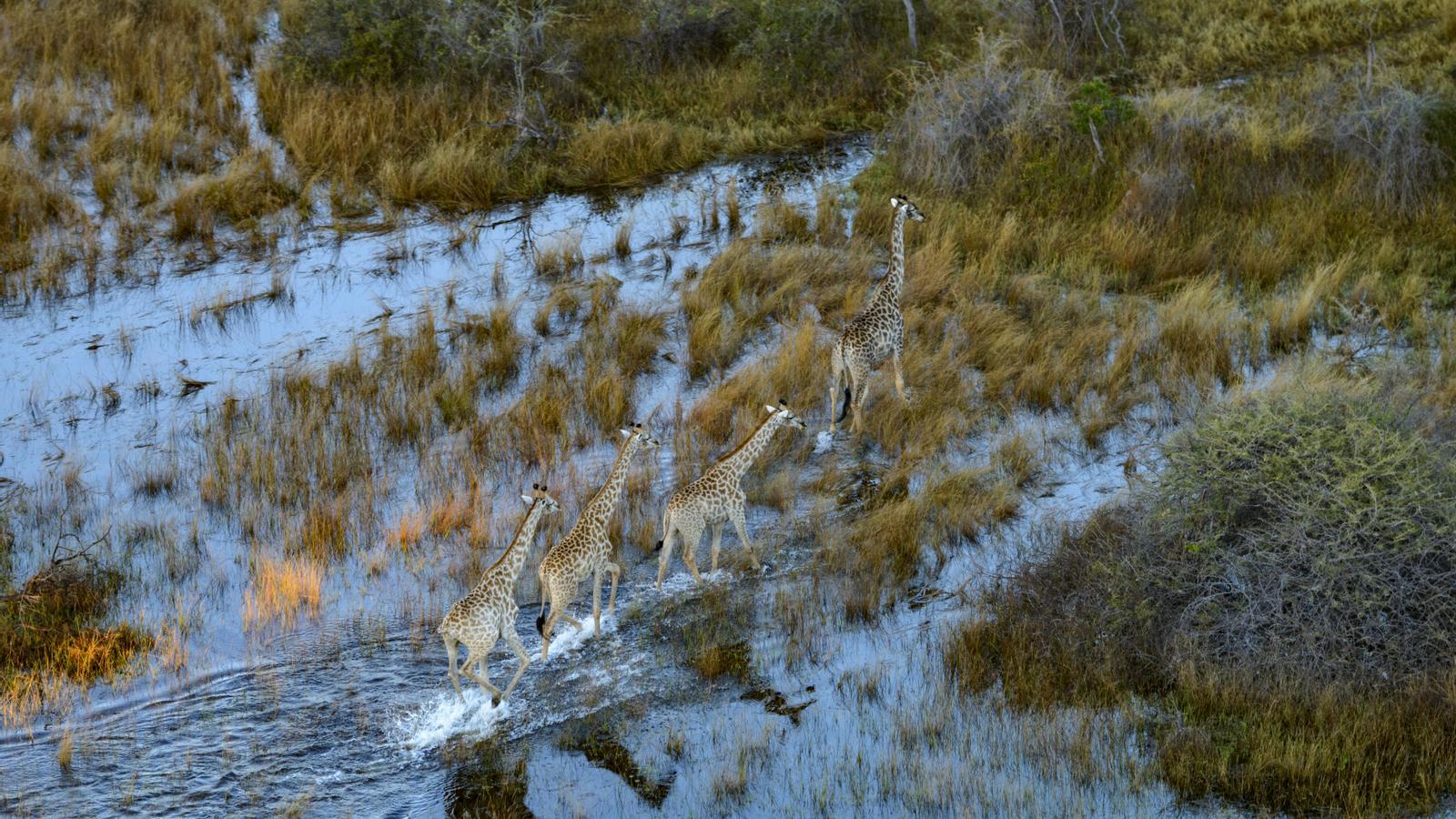Journey to the Okavango, the African river that stops the desert
The delta of this unique African river is a catalogue of biodiversity and instead of dying in the sea, it vanishes beneath the sand of the Kalahari Desert.


MaunThe Okavango Delta can be admired from the air. And then, calmly, it's time to set foot on land and, above all, to navigate the meanders formed by this river before vanishing beneath the desert sand. Precisely this whim of nature makes the Okavango Delta an extraordinary paradise, and from a small plane or a balloon, the best view is obtained, perhaps the only one capable of capturing the scope of this place, for which synonymous adjectives like "impressive" or "wonderful" have run out.
Perhaps because of our latitudes, we don't know what the Okavango is, and, overwhelmed by the immensity of Africa, we haven't been able to appreciate it properly. We will say, as a note or as an insult, that some people attribute the best sunsets in the world to this place. But before continuing, we should imagine a river that travels some 1,200 kilometers from its source in the mountains of Angola, crosses the Caprivi Strip of Namibia, and dies without being able to reach the sea because, on its way, it suddenly encounters the Kalahari Desert, northwest of Botswana.
Its journey is very slow, and the waters take more than three months to make the journey, so, paradoxically, when the dry season arrives (from May to October), the river floods the final stretch and spreads over a vast area that, to give us an idea, occupies half of Catalonia. Around July (in the southern hemisphere's winter) is the peak of the water, which begins to retreat towards the southern hemisphere's spring to begin the cycle again.
As we mentioned, with no outlet to the sea, the river flows through wetlands, channels, and meanders outlined by papyrus, water lilies, and reeds. From a bird's eye view, the image is that of a green blanket where, in this time of splendor, some of the more than 100,000 islands of all sizes can be seen, some of which, to make it even more Instagram-worthy, are heart-shaped.
The Rain Cycle
The dry and rainy seasons mark the delta's landscape, but for the best view, it's advisable to choose the driest season, as this is also when you can find the most animals, as the fauna concentrates around the river. This is one of the emblematic places to glimpse the so-called Big Five, the Big Five animals of the African savanna: the leopard, the lion, the rhinoceros, the elephant, and the black buffalo. But beyond these five, there are more than 2,000 animal and plant species concentrated in this area, coexisting with thousands of people who depend on it for their livelihoods.
Introductions made, the majesty of the Okavango Delta was added to the UNESCO World Heritage List in 2014, but this recognition has not spared it from being under several threats that raise fears for the future of this unique ecosystem in the world. We will return.
The most common entry into the delta is Maun, Botswana's third largest city that has grown in the shadow of the attraction generated by the Okavango. Surely, without the delta, it would be a town that would go unnoticed by the traveler, but once you enter, there is a constant hustle and bustle and the bungalows are mixed with shops: gas stations, supermarkets or the lodges, rural accommodations for those who want to go on safari. It's a mandatory stop to stock up on everything you need once you enter the delta and is the gateway to Moremi, an animal reserve that, while not one of the country's major national parks, packs a punch.
The facilities at Maun Airport are modern, despite their simplicity. Flights from cities in the southern African region land here, and small planes and helicopters also take off from here. These, with modest prices, are the only ones capable of offering a panoramic flight over the immensity of the delta. When the engines start and the aircraft begins to climb, the red sand runway is quickly left behind, revealing a visual feast. Your eyes can't keep up because they don't know what they're looking for; The passengers share the excitement of being the one to call "there!"—a signal that could mean spotting a herd of elephants at the sign of one of the curves the Okavango seems to be entertaining. The flight experience is cut short—around thirty minutes—and the €300 bill is definitely a price to be paid by the privileged and capricious.
But the Okavango, we said, is admired as birds do, from above. And then it's true that you also walk on it and, above all, you sail. Perhaps the order is reversed, because to reach the larger islands there is only the waterway. Without roads, it's the turn of the mokoro, the local canoe that was traditionally built of wood and is now mostly made of fiberglass, a more durable and sustainable material. A guide propels the boat with a long, thin pole that he sticks into the river. If there's one word that describes the feeling, it's peace. Or tranquility. Look for synonyms for that feeling of being in bliss, knowing that not even in the best screens or the best dreams have we been guided through clear waters filled with water lilies.
The rule is not to move during the entire journey and not to make a sound. Tranquility, because it's a very simple goal: words are unnecessary, and any distraction is a waste of time and an opportunity to watch the rich life that exists among the reeds pass by. In silence, sitting on the riverbank, the Okavango is a catalog of whistles and bird calls, and hippo grunts. Sounds that combine perfectly with the friction of the boat gliding through the water.
The wonder is made real because the entry privilege includes the possibility of spending the night on the islands. There are some that have not been invaded by the tourist's desire for Asian luxury in the heart of Africa and still maintain the simple offering of tents set up around a fire on the ground. This is probably the best option, because it's economical, because it's in direct contact with all the night noises, and, if you're lucky, because it's a good chicken or cudú stew accompanied by buche, a kind of porridge that serves as bread. Not to mention camping, but of projects that exploit the local communities that inhabit these lands, such as the San (the oldest people in the region) or the Twsuana, the Herero either the basubiyaque. A separate chapter is the large tourist complexes and lodges in the purest style of Out of Africa, which are gaining ground in tourist catalogs. Perhaps it's better to forgo such comforts to be able to take a river trip before sunset and cross our fingers that chance or a local deity will match us with animals.
On the mainland, there is a festival of acacias and baobabs, but if there's one element that surprises, it's the termite mounds, which can grow to two or three meters in height. Although they may seem like simple mounds planted haphazardly, the truth is that they are crucial to keeping the Okavango ecosystem alive. In fact, we're putting it mildly: these insects can be attributed to the formation of this enormous delta because, thanks to these mud structures and the trees that grow within them, the flow of river water is impeded and, in addition, they serve as the basis for the creation and modification of the islands.
Heritage at risk
You come to the Okavango once, but the river flows through your mind for a lifetime, locals tell tourists. It refuses to disappear from our best memories, but beware, because today the delta faces several threats that could endanger biodiversity and life. Within this territory live endemic and endangered species, and any change could be lethal. UNESCO wanted to distinguish these landscapes by declaring them, in 2014, World Heritage and, in addition, the government of Botswana has laws and policies to protect this territory..
But all this protection has not prevented the emergence of projects that attempt to exploit the delta's wealth. Environmentalists and local communities warn that, if they go ahead, it will mean the end of life as we know it. One of the major threats is excessive water extraction. The Okavango is the great reserve of the entire region and could be jeopardized if Angola – upstream – authorizes the increase in agricultural industries that will require a lot of water and, without a doubt, will impact the river flows and, of course, the delta ecosystem.
The other major threat, in fact, is twofold: gas and oil. A Canadian-owned company, ReconAfrica (Reconnaissance Energy Africa Ltd) Last year, the company renewed its licenses to continue prospecting for these two elements, and there are fears that some incident or accidental spill could put an end to the life hidden beneath the clear waters of the river. It is even accused of using the dangerous technique of fracking, which causes noise and disturbance to wildlife, although, for the moment, no work has begun in Botswana and has limited itself to neighboring Namibia.
But on this journey along the river that disappears beneath a desert, there can only be one good ending. Maun is once again the reference, the crossroads from which you can continue the journey through the neighboring parks of Chobe and Savuti, for those who do not want to leave Botswana, or take a plane to the Victoria Falls, spread between Zambia and Zimbabwe. The last chance to admire the Okavango.
